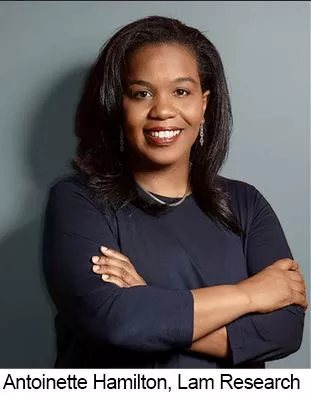Observing Black History Month and the Importance of Inclusion and Diversity in the Semiconductor Industry
“Diversity is not about how we differ. Diversity is about embracing one another’s uniqueness.” — Ola Joseph, Nigerian-born speaker and author
“Never be limited by other people’s limited imaginations.” – Dr. Mae Jemison, first African-American female astronaut
In 1976, then U.S. President Gerald Ford officially recognized Black History month. He urged Americans to “seize the opportunity to honor the too-often neglected accomplishments of Black Americans in every area of endeavor throughout our history.” Canada observes Black History month in February. In Ireland and the United Kingdom it is observed in October.
The SEMI Foundation invited Antoinette Hamilton, Global Head of Global Inclusion and Diversity and Senior Director of Employee Engagement at Lam Research, to reflect on the semiconductor industry’s progress towards diversity, why inclusion is critical to everyone’s success and how companies and leadership can affect greater change. Hamilton is a member of the SEMI Foundation Advisory Council and a frequent speaker at SEMICON West and other events related to workforce development and diversity, equity and inclusion (DEI).
Kindling: Why does inclusion and diversity in the semiconductor industry continue to be important?
Hamilton: Inclusion and diversity (I&D) in the semiconductor industry has a direct impact on innovation. Semiconductors are becoming more and more complex, and scaling is becoming harder and taking longer. When organizations fail to incorporate diversity and inclusivity into talent practices, large talent pools may get overlooked. That doesn’t just impact the efforts toward workforce diversity. It has direct implications for corporate strategy and performance. By bringing together talented individuals with different backgrounds, experiences and perspectives, you are cultivating a foundation for innovation to thrive.
Kindling: What progress have you seen regarding inclusion and diversity since joining Lam Research in 2020, either at Lam or in the industry?
 Hamilton: When I started at Lam in 2020, processes and key activities were already in place. Since then, I am proud of the fact that we established Inclusion & Diversity as part of our Core Values, underscoring our commitment to creating and cultivating an environment where people from different backgrounds can thrive. Employee perspectives are welcome, heard, and valued. At Lam, this meant building a strategy and further integrating I&D into our processes, taking it from a concept that runs alongside our business to integrating into our ways of working.
Hamilton: When I started at Lam in 2020, processes and key activities were already in place. Since then, I am proud of the fact that we established Inclusion & Diversity as part of our Core Values, underscoring our commitment to creating and cultivating an environment where people from different backgrounds can thrive. Employee perspectives are welcome, heard, and valued. At Lam, this meant building a strategy and further integrating I&D into our processes, taking it from a concept that runs alongside our business to integrating into our ways of working.
In just the last few years, Lam has continued to make important strides on its I&D journey. Our employee resource groups and partnerships have been integral to our progress. We have also focused on skill-building and education. We believe that transparency and learning from each other is key, which is why we share our progress in our annual ESG report.
More broadly, the semiconductor industry continues to focus on increasing diversity as well. For example, Lam is part of the SEMI Foundation Advisory Council and the Alliance for Global Inclusion and other organizations that are collectively working together towards I&D actions. What makes me hopeful is that our industry is good at solving tough problems and it continues to close the gaps.
Kindling: What can industry leaders do to better engage and inspire Black students to pursue a career in the semiconductor industry?
Hamilton: Show up in local communities. Partner with local community organizations. We need to show up in those communities as partners and listen to how we can add value. For example, we are proud of our relationship with the East Oakland Youth Development Center, where we have provided funding for a computer-aided design (CAD) program pilot. Launched in 2022, the program was developed to expose high-school students to the fundamentals of CAD and the various career opportunities within the field.
Being able to go to the community and explain the industry is an important first step. You can’t expect the community to come to you; you have to show up within the community in an authentic way.
Kindling: What advice would you give a company who is considering DEI initiatives?
 Hamilton: First, get crisp on why you are doing the initiative. Before you set a strategy, start with an introspection of what you want to accomplish and why you want to accomplish it. It is critically important to get clear on why you are doing this work and understand it is going to be a journey. Then, start gathering and integrating resources, whether through partnerships or third-party assistance. Learn from them. For Lam, one thing that has been valuable has been our collaborations with groups such as the Alliance for Global Inclusion and Out and Equal.
Hamilton: First, get crisp on why you are doing the initiative. Before you set a strategy, start with an introspection of what you want to accomplish and why you want to accomplish it. It is critically important to get clear on why you are doing this work and understand it is going to be a journey. Then, start gathering and integrating resources, whether through partnerships or third-party assistance. Learn from them. For Lam, one thing that has been valuable has been our collaborations with groups such as the Alliance for Global Inclusion and Out and Equal.
Kindling: You are a graduate of Hampton University, a historically Black university. How can semiconductor companies better engage with Historically Black Colleges and Universities (HBCUs)?
Hamilton: Semiconductor companies can better engage with HBCU’s by first building and maintaining relationships with these intuitions, and then going a step further to build relationships with professional organizations that are connected into the diverse networks – beyond HBCU’s – such as the National Society of Black Engineers and AfroTech. Some of our outreach has also extended into community colleges, which can be another avenue for sourcing diverse talent.
Recently, Lam welcomed students and faculty from a local community college to tour our labs and learn more about the work we do.
Lam also supports scholarships for the United Negro College Fund (UNCF). Since 2022, Lam has funded 54 UNCF scholarships.
Kindling: You recently participated in a Women in Semiconductors (WiS) panel discussion organized by the SEMI Foundation. What was your biggest takeaway or most inspiring moment from that conversation?
Hamilton: Many of the panel participants made a key connection that I found not only surprising, but also inspiring, particularly when they spoke about their role models. My role model is my mom and one of the speakers had the same answer. My mother has been a vital role model in my work by demonstrating the power of perseverance and that ability to overcome challenges with grace.
Learn more about fostering workplace inclusion and equity. Download the SEMI Foundation DEI Roadmap and Toolkit and find resources on how to engage in Crucial Conversations.
About Antoinette Hamilton
Antoinette Hamilton is Global Head of Inclusion and Diversity at Lam Research. In her role, she drives the strategy for diversity and inclusion initiatives, aligning with executive and senior management; consulting on and embedding best practices across recruiting, employee development, and business processes; and developing key partnerships to foster a diverse workforce.
Margaret Kindling is Senior Program Manager for DEI at the SEMI Foundation. She manages Women in Semiconductors, Semiconductor Day and WFD/DEI programming at SEMICON West.











